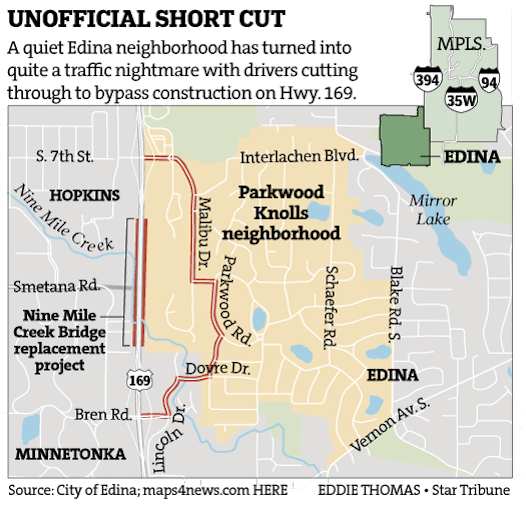The quiet streets of Parkwood Knolls are gone. Instead the meandering roads in this Edina neighborhood of million-dollar homes have become clogged with stop-and-go traffic as commuters take their own detours off the nearby stretch of Hwy. 169 that shut down in January.
Neighborhood residents have had a parade of complaints for the past six weeks since the Nine Mile Creek bridge was closed, displacing nearly 90,000 motorists a day. Edina and the Minnesota Department of Transportation are listening to concerns and going to extreme lengths to lessen the blow on the neighborhood.
The latest action: Edina, in a trial run, stationed police officers and blocked off the north entrance to the neighborhood for two hours each morning at Lincoln and Malibu drives. The same thing occurs for two hours each afternoon at the south entrance on Dovre Drive. The city and MnDOT also put up a sign warning app-armed drivers looking for a short cut around the Nine Mile Creek bridge closure that they would not have access to Hwy. 169.
Resident Paul Manly said it's a start, but it doesn't go far enough to stop angry and aggressive drivers from slaloming around bikers and walkers, all while ignoring stop signs, school bus stop arms and even using driveways to skirt midblock stop signs and barricades that narrow the road so only one vehicle can pass at a time
"This is just a Band-Aid for a week," said Manly, who is worried that it will take someone getting killed before more extreme measures are put in place. "This is working well, but when the cop isn't there, there will be a whole new flow of people. It [the traffic] will come right back."
Manly, like some other residents, wants the main routes of the rogue detours closed.
Officially, the detours keep traffic off Hwy. 169 between the Crosstown and I-394. Northbound drivers are asked to follow Hwy. 62 east to Hwy. 100, then north to I-394 and back west to Hwy. 169. Southbound drivers are being sent west on I-394 then south on I-494.
But only the stretch between Bren Road and Lincoln Drive/5th Street are closed, forcing motorists onto those exit ramps. Immediately following the Jan. 23 closure, problems began for the neighborhood, which has lavish houses, big yards and lots of kids. Traffic volumes rose fivefold from 1,000 vehicles a day to 5,100 in the days following the shut down.
Two weeks later, after putting in chicanes — the midblock stop signs that make it inconvenient to get through — traffic volume fell to 3,800 a day. Then this week the city started rush hour closures with police at a cost of $85 per hour covered by MnDOT. Counts fell to 2,500, which is in line with other city streets, said city traffic engineer Chad Millner.
Still, Malibu Drive resident Margaret Davis is upset that it took weeks for the city to take all those steps. "Why was that sign not here six weeks ago?" she said of the no access sign. "They have been extremely slow to make any changes and that has aggravated drivers more than anything."
Millner said he is sympathetic with residents' concerns, but that Edina has been prudent, not slow. He said the city wants to make informed decisions based on sound data and the impact on the wider area and services, such as fire and police.
The city, he said, is well aware of the traffic volumes and is incrementally making changes rather than just jumping to a worst-case scenario. "If we do it too quickly, we don't know what changes affected the traffic," he said.
"We knew there would be more traffic than before construction. It [the rush hour closures] has knocked down traffic at the peak time, and that is what we were hoping for. We are trying to find a balance. Safety is the No. 1 priority."
Originally the rush hour restrictions were to be in place this week only, but Millner said that because they've been effective they will remain in place through next week, and possibly longer.
The city also is looking to extend them for 30 minutes more to curb the spike in traffic just before and after they go into effect, Millner said.
As they push for more action, fed up residents, at times, have taken matters into their own hands.
Lindsay Sokolowski said many residents purposely now drive at 19 miles per hour to slow traffic down and remind motorists that they are in a neighborhood.
Others have confronted traffic intruders, which has led to highly charged altercations.
One woman tried that and it led to the "scariest moment of her life" when a driver ignoring the posted detour threatened to "blow her head off," she said.
A spokesman for MnDOT acknowledged that the neighborhood has seen more traffic than anticipated, but that the agency didn't just dump traffic there. Often, with construction, it takes time for motorists to adapt and find alternate routes, said spokesman David Aeikens.
"It's difficult to gauge where traffic will go," he said. "You try different things and give them time to see if they work and then you react. We partner with Edina, but these are Edina's roads and they decide what to do with them. If everybody had gone on I-494 and Hwy. 100, it would have been just fine."
Davis said she is relieved every day when the two two-hour restrictions go in place. "It goes back to the neighborhood we used to have." But to solve a problem that might be around until MnDOT finishes its work in October, "the only way to fix it is to close the road."
Tim Harlow • 612-673-7768

Ex-Hennepin sheriff paid for drunk-driving damages with workers' comp

Souhan: This is KAT's chance to prove Flip Saunders was right



